Lake Mburo National Park, located in the western part of Uganda, is a popular destination known for its diverse wildlife and stunning landscapes. One of the major attractions of this national park is its abundant birdlife.
The park boasts over 350 recorded bird species ranging from waterbirds, savannah, and woodland birds. The presence of the lake Mburo near the park provides a significant habitat for the birds, making it a birder’s paradise.
The birds in Lake Mburo National Park are not only visually appealing, but they also play a crucial role in the park’s ecosystem.
In this article, we will explore the different bird species found in the park, their unique features, and why they make this park an excellent spot for bird watching.
1. Pied Kingfisher
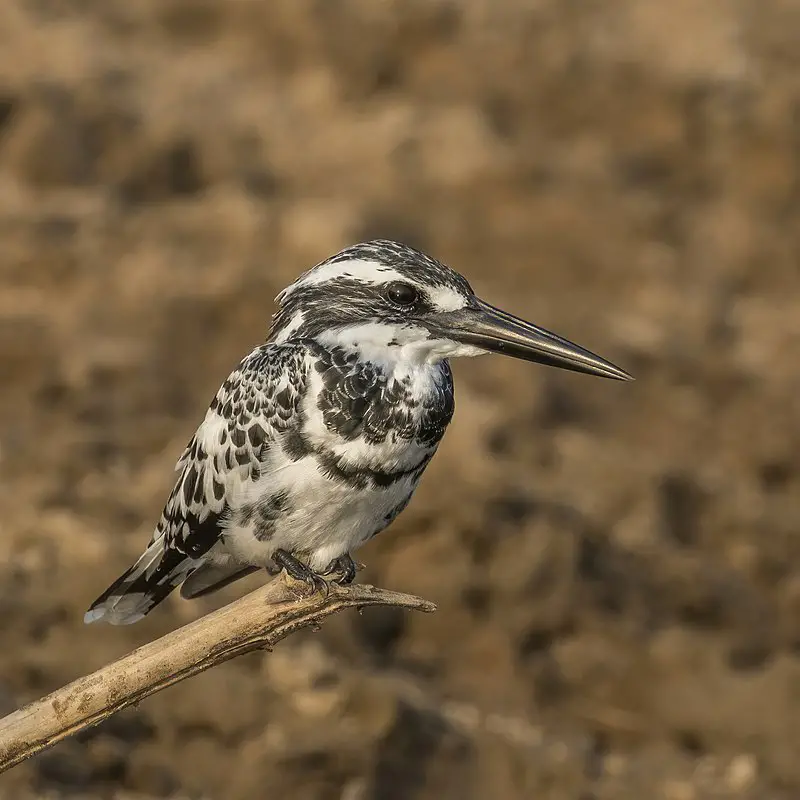
The Pied Kingfisher is a species of water kingfisher found in Africa and Asia. It has black and white plumage, with males sporting a double band across the breast while females have one single band.
This bird makes its presence known by hovering over clear waters before diving for fish – making it easily recognizable.
The diet consists mostly of small aquatic animals such as frogs, crustaceans and insects, but they also consume some plant matter like seeds or fruits occasionally.
The pied kingfisher nests near bodies of water where it can feed off smaller creatures that dwell there; usually in burrows dug into riverbanks or on floating vegetation close to shorelines.
With their distinct colors and behavior patterns these birds make an interesting addition to any wildlife enthusiast’s list.Scientific classification:
| Kingdom | Animalia |
| Phylum | Chordata |
| Class | Aves |
| Order | Coraciiformes |
| Family | Alcedinidae |
| Subfamily | Cerylinae |
| Genus | Ceryle F. Boie, 1828 |
| Species | C. rudis |
Also Featured In: Native Pakistani Birds, Lebanon Birds Live in Semi-Desert Areas
2. Bare-Faced Go-Away-Bird
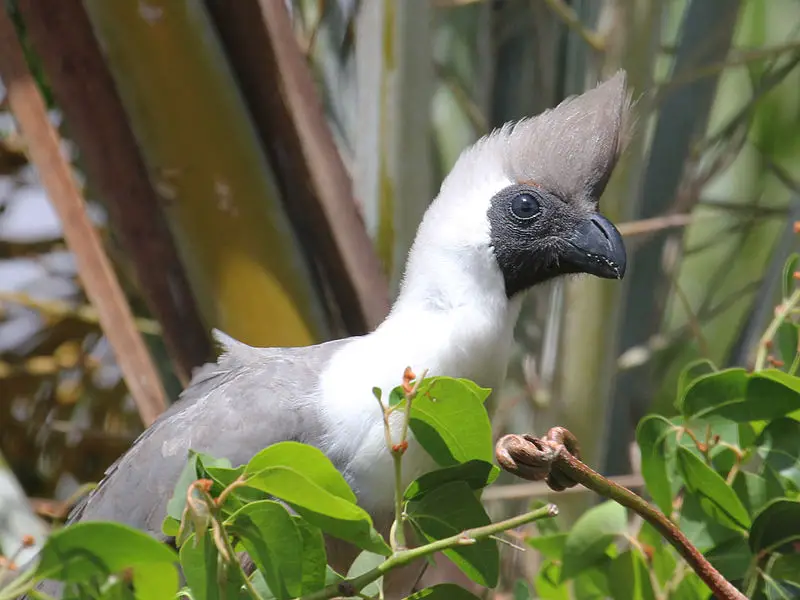
The Bare-faced go-away-bird is an eye catching species of bird native to eastern Afrotropics. It stands out due to its unique bare black face, setting it apart from other birds in the Musophagidae family.
Both sexes are similar except for the female’s green beak and both measure about 19 inches long with a weight of 210 – 300 grams.
These birds make quite a bit of noise as they move around restlessly throughout their habitat, making them easily recognizable by sound alone.
They feed mainly on fruits such as figs and berries which gives them plenty energy for all that movement.
All in all, this species makes an interesting addition to any nature enthusiast’s list of sightings or even just backyard visitors.Scientific classification:
| Kingdom | Animalia |
| Phylum | Chordata |
| Class | Aves |
| Order | Musophagiformes |
| Family | Musophagidae |
| Genus | Crinifer |
| Species | C. personatus |
Also Featured In: Common Ethiopian Birds, Endemic Ethiopian Birds You don’t Know
3. Malachite Kingfisher
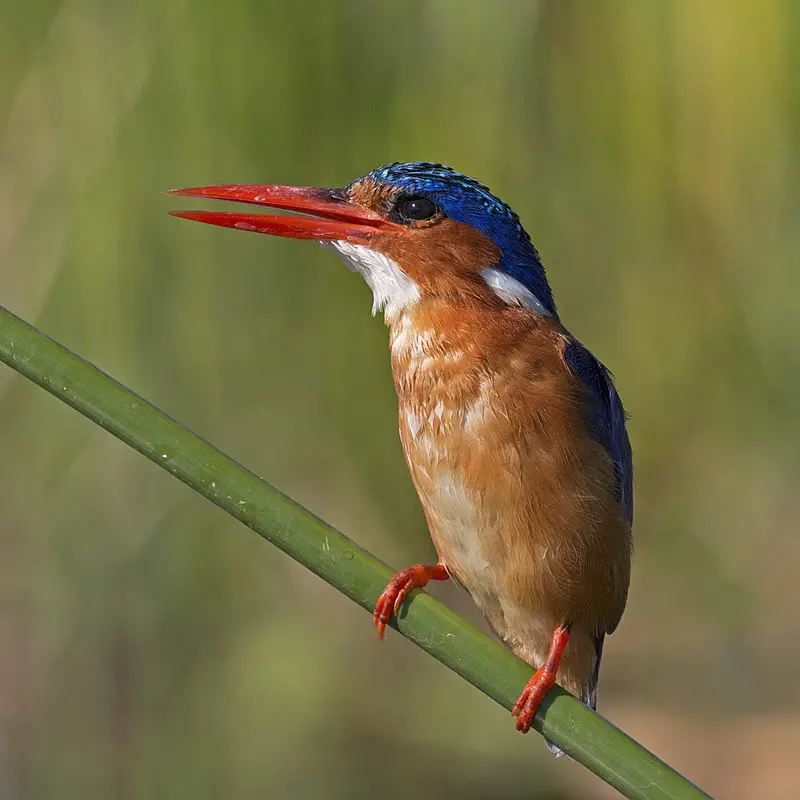
The Malachite Kingfisher is a beautiful bird found in Africa south of the Sahara. It has bright blue wings and tail, with greenish-black upperparts, white chin and breast and orange lower belly.
The species was first described by German naturalist Peter Simon Pallas in 1764 who gave it its binomial name “Alcedo cristata”.
This kingfisher typically inhabits rivers where it feeds on fish, frogs as well as aquatic invertebrates like crustaceans and insects.
Although mainly resident throughout the year, some do make seasonal movements due to climate changes.
These birds are monogamous during breeding season which usually lasts from August till October when they build their nests inside river banks or overhanging vegetation near water bodies.Scientific classification:
| Kingdom | Animalia |
| Phylum | Chordata |
| Class | Aves |
| Order | Coraciiformes |
| Family | Alcedinidae |
| Subfamily | Alcedininae |
| Genus | Corythornis |
| Species | C. cristatus |
Also Featured In: Birds of Tanzania, African Birds
4. Blue-Headed Coucal
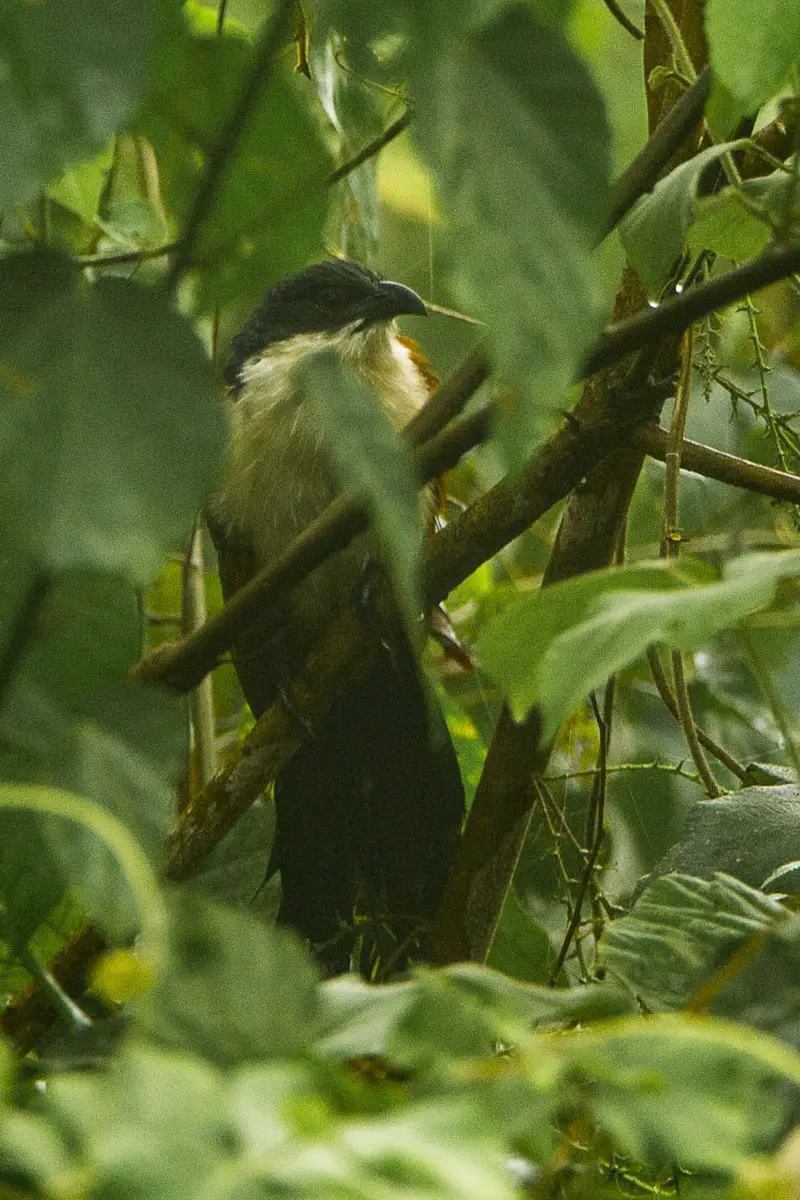
The Blue-headed coucal is a beautiful and unique species of cuckoo found in tropical central Africa. It inhabits areas near swamps, rivers, forests edges and other wet environments.
This bird is quite common with a large range which has led the IUCN to rate its conservation status as “least concern”.
Its distinguishing feature are its striking blue head feathers that it uses for courtship displays when searching for mates during breeding season.
The diet consists mainly of insects but can also include small reptiles or amphibians if available.
Despite their wide range they remain vulnerable due to changes in land use such as deforestation or agricultural development so careful monitoring must continue to ensure the survival of this charming species.Scientific classification:
| Kingdom | Animalia |
| Phylum | Chordata |
| Class | Aves |
| Order | Cuculiformes |
| Family | Cuculidae |
| Genus | Centropus |
| Species | C. monachus |
Also Featured In: Common Kenyan Birds,
5. Greater Painted-Snipe
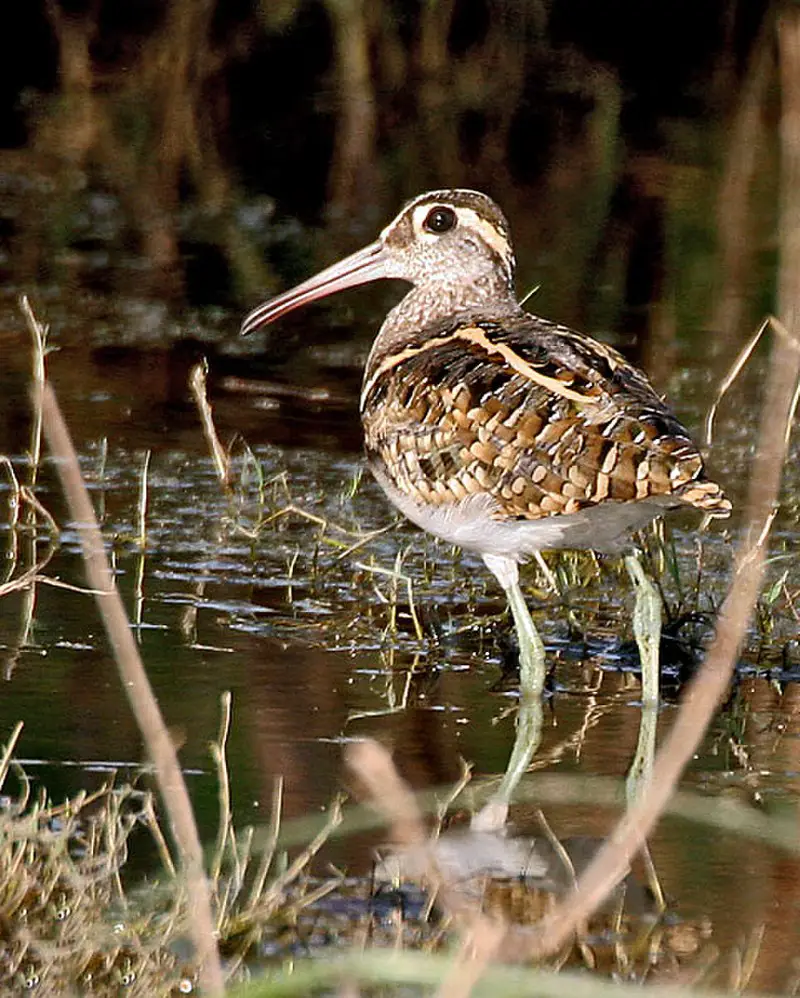
The Greater Painted-snipe is a medium-sized, plump wading bird found in marshes throughout Africa, South Asia and Southeast Asia.
It has distinctive features that make it stand out from its peers: a long reddish brown bill slightly curved at the tip with an eye patch of white or pinkish coloration; rounded wings speckled with buff spots; and a short tail.
The breast of this species has extensive white plumage which extends up around the top of its folded wing.
With its unique appearance, this avian beauty stands out among other birds in wetland habitats.Scientific classification:
| Kingdom | Animalia |
| Phylum | Chordata |
| Class | Aves |
| Order | Charadriiformes |
| Family | Rostratulidae |
| Genus | Rostratula |
| Species | R. benghalensis |
Also Featured In: Native South Korean Birds, Hong Kong Birds You Need to See
6. Black-Bellied Bustard
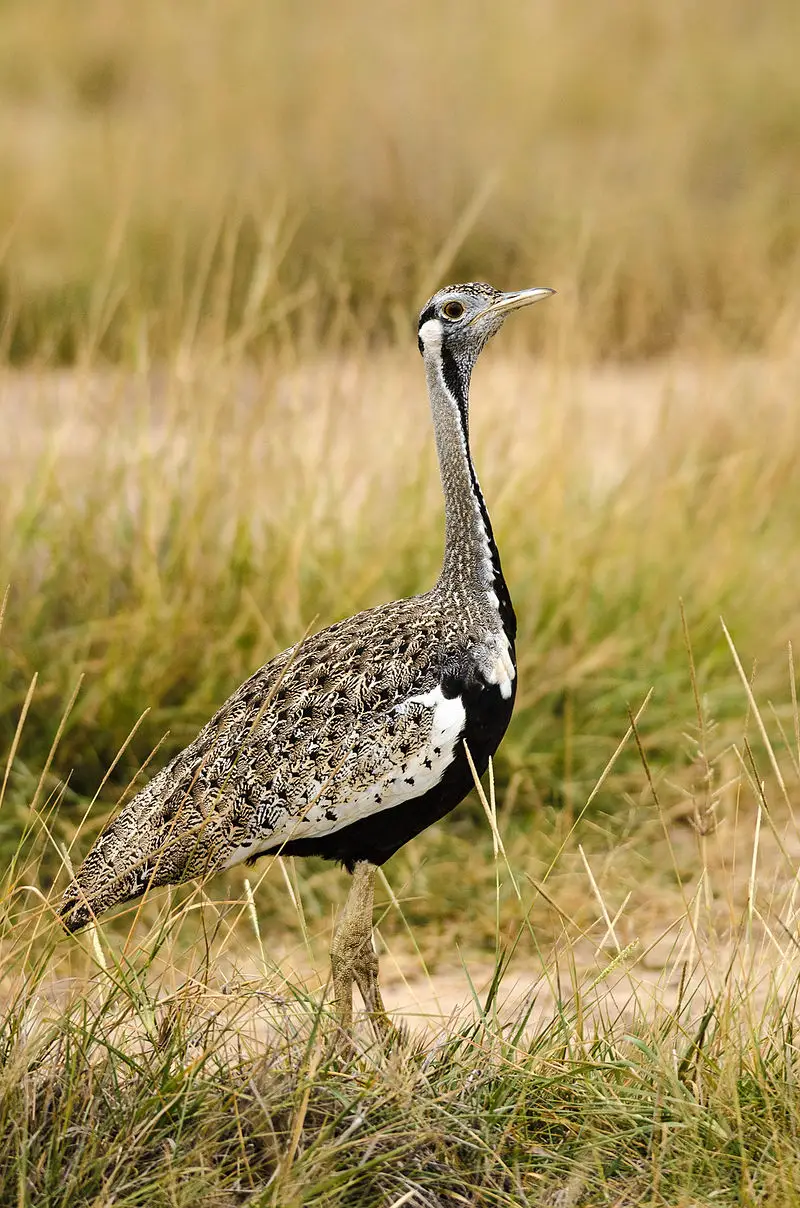
The black-bellied bustard is a fascinating bird, native to Africa. It belongs to the Bustard family and measures between 58–65 cm (23–26 in) long.
This beautiful creature has tawny buff upperparts with black and brown marks on it, while its underparts are entirely black.
Its head stands out due to bold patterns of white, buff and black feathers which make for an impressive sight. The bill and legs of the Black-bellied Bustards have dull yellow coloration.
These birds live on the ground rather than in trees or bushes like other members of their species usually do – making them quite unique among African birds.
They can be found mostly in grasslands where they feed mainly on insects as well as small rodents occasionally too.Scientific classification:
| Kingdom | Animalia |
| Phylum | Chordata |
| Class | Aves |
| Order | Otidiformes |
| Family | Otididae |
| Genus | Lissotis |
| Species | L. melanogaster |
Also Featured In: Most Unique Birds in Niger, East African Birds
7. Yellow-Fronted Tinkerbird
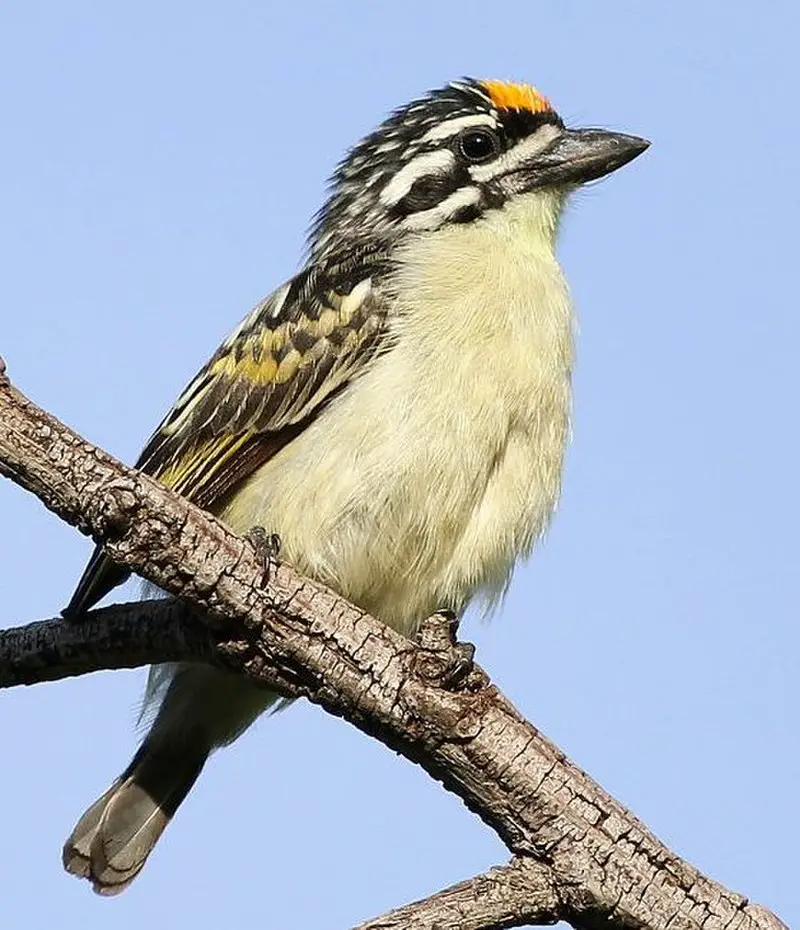
The yellow-fronted tinkerbird is a small African barbet found throughout tropical regions of the continent. It is easily recognized by its bright yellow forehead and brownish plumage, which may vary among different subspecies.
These birds feed mainly on insects and fruit; they use their stout bill to break open hard fruits while searching for food in dense vegetation.
They tend to live in pairs or family groups that occupy large territories, with males singing loudly from prominent perches during breeding season as part of territorial defense.
The population appears stable overall but some subspecies are considered threatened due to habitat destruction and fragmentation.Scientific classification:
| Kingdom | Animalia |
| Phylum | Chordata |
| Class | Aves |
| Order | Piciformes |
| Family | Lybiidae |
| Genus | Pogoniulus |
| Species | P. chrysoconus |
Also Featured In: Birds of Malawi,
8. Red-Faced Barbet
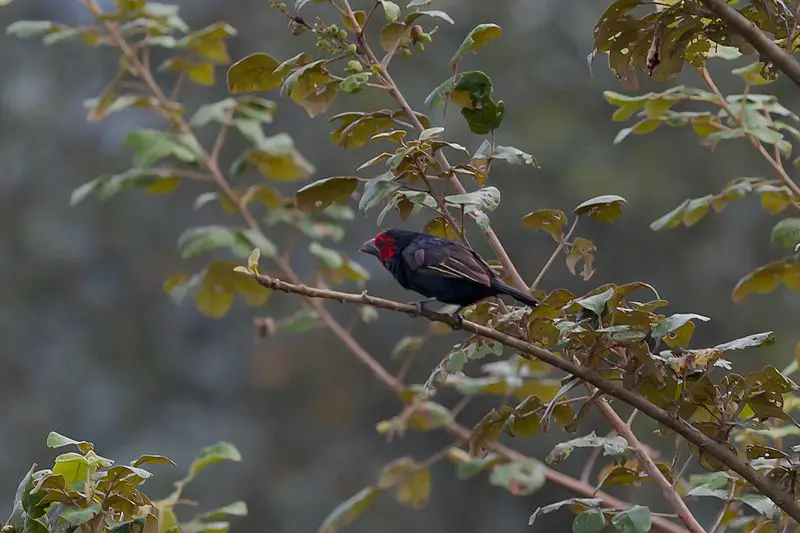
The Red-faced barbet is a captivating bird belonging to the African barbet family Lybiidae. It is found in Burundi, Rwanda, Northwest Tanzania and Southwest Uganda and inhabits dry savanna, moist savanna and arable land.
At only 17 cm (6.7 inches) long it’s one of the smaller species from this family. Its unique red coloring on its sides make it stand out amongst other birds in its habitat as well as being incredibly striking when seen up close.
Unfortunately due to loss of habitat this magnificent creature has become endangered but conservation efforts are continuing so that future generations can continue to admire their beauty for years to come.Scientific classification:
| Kingdom | Animalia |
| Phylum | Chordata |
| Class | Aves |
| Order | Piciformes |
| Family | Lybiidae |
| Genus | Lybius |
| Species | L. rubrifacies |
Also Featured In: Top Birds of Rwanda, Endemic Birds of Uganda that You Need to Know
9. African Wattled Lapwing
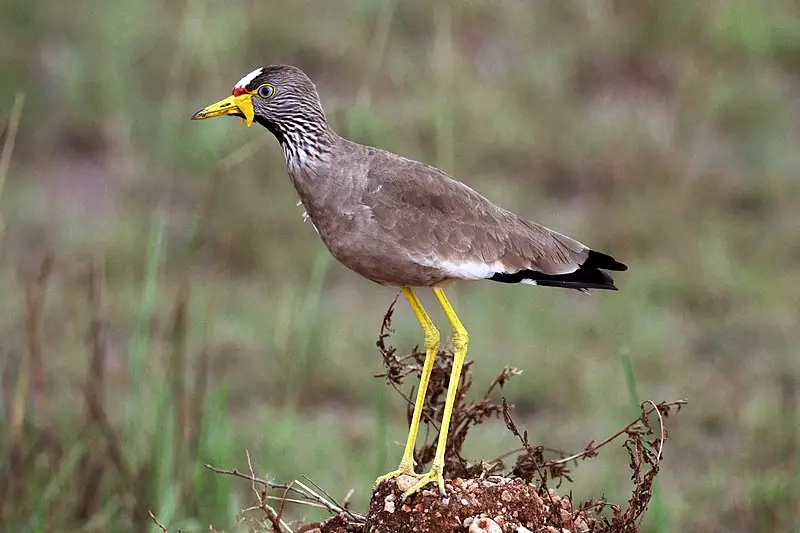
The African wattled lapwing, also known as Senegal wattled plover, is a remarkable bird species found mostly in sub-Saharan Africa. It’s a large wader that doesn’t migrate much except during seasonal movements.
These lapwings are distinctively conspicuous and hard to miss with their unmistakable features.
They have a brown coloration and a black crown above their head. One of their unique features is the black facial wattles, which are large and fleshy.
African wattled lapwings are known to breed in open habitats outside of the rainforests, and they are dominant in their territories.
Their diet mostly consists of insects and other small animals, and they are known to care for their young ones until they can fly.
These endearing birds are a sight to see, but their populations are under threat due to human activities like habitat destruction and overexploitation.Scientific classification:
| Kingdom | Animalia |
| Phylum | Chordata |
| Class | Aves |
| Order | Charadriiformes |
| Family | Charadriidae |
| Genus | Vanellus |
| Species | V. senegallus |
Also Featured In: Birds You’ll Find in Kenya Safari, Johannesburg Birds You Need to Know
10. Papyrus Gonolek
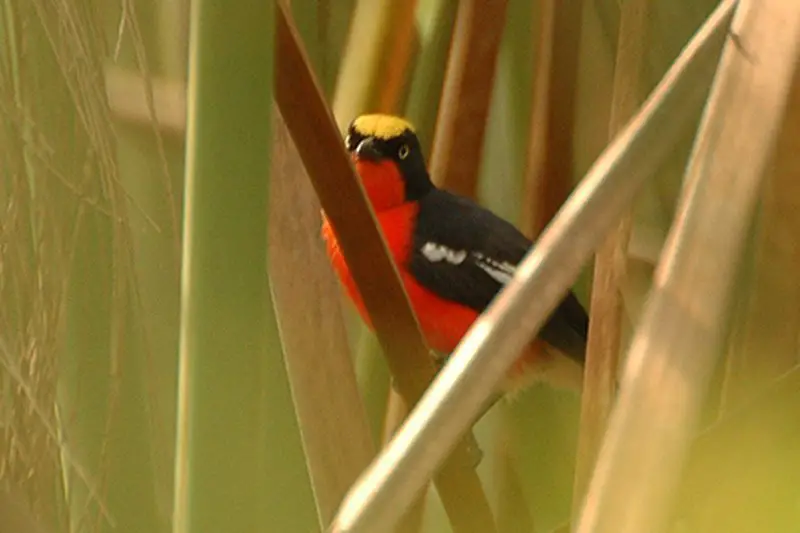
The Papyrus Gonolek is a medium-sized bush-shrike that is found in Burundi, Democratic Republic of the Congo, Kenya, Rwanda, Tanzania, and Uganda. This bird has specialized habitat requirements and is restricted to papyrus swamps.
Unfortunately, it has become rare due to habitat loss and pollution but is not yet considered a threatened species.
The Papyrus Gonolek has a distinctive appearance with its bright red breast and is known for its unique call.
This bird is an important indicator species and its presence in a wetland habitat can indicate the health of the ecosystem.
Efforts are being made to conserve its habitat and protect its populations to ensure that these beautiful birds can continue to thrive in their natural environment.Scientific classification:
| Kingdom | Animalia |
| Phylum | Chordata |
| Class | Aves |
| Order | Passeriformes |
| Family | Malaconotidae |
| Genus | Laniarius |
| Species | L. mufumbiri |
11. White-Headed Barbet
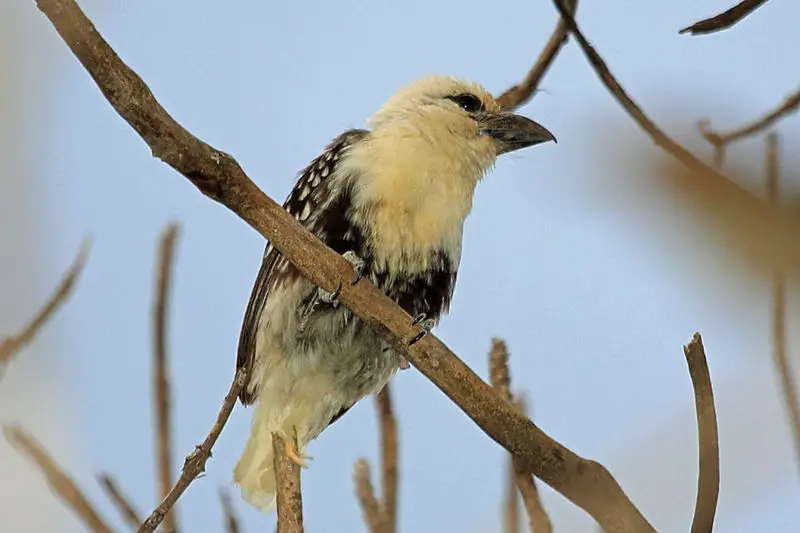
The white-headed barbet is a bird species belonging to the family Lybiidae. It can be found in several African countries including Nigeria, Chad, Cameroon, and Tanzania.
This particular species of African barbets has different races that can be distinguished by their unique duetting song patterns, but all of them are known for their raucous greeting ceremony.
The bird has distinctive black and white markings, and as its name suggests, a white head. It mainly feeds on fruits, but may also eat insects and seeds.
The bird’s habitat is usually dense forests, and it is considered to be of least concern when it comes to conservation status.
The white-headed barbet is an important component of Africa’s rich avifauna.Scientific classification:
| Kingdom | Animalia |
| Phylum | Chordata |
| Class | Aves |
| Order | Piciformes |
| Family | Lybiidae |
| Genus | Lybius |
| Species | L. leucocephalus |
12. Yellow-Rumped Tinkerbird
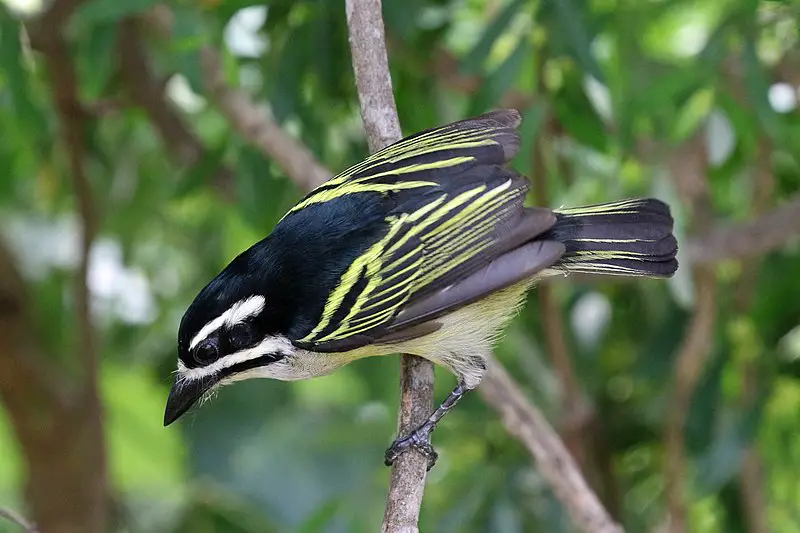
The Yellow-rumped tinkerbird is a bird species found in sub-Saharan Africa. It belongs to the family Lybiidae and is native to moist tropical and subtropical regions.
Formerly, it was classified under the family Bucconidae, which has now been divided.
Alternatively, it could be part of the expanded Ramphastidae family of toucans. The scientific name of this bird species is Pogoniulus bilineatus.
This tinkerbird boasts distinctive yellow feathers at the base of its tail, which is how it gets its name.
It is a small bird with a greenish-yellow plumage that blends well with the lush vegetation in its natural habitat.
Like other tinkerbirds, it is known for its tinkering call, which is used to stake out territories and communicate with their mates.
The Yellow-rumped tinkerbird is an important species of bird in its ecosystem as it aids in pollination and insect control.Scientific classification:
| Kingdom | Animalia |
| Phylum | Chordata |
| Class | Aves |
| Order | Piciformes |
| Family | Lybiidae |
| Genus | Pogoniulus |
| Species | P. bilineatus |
13. Carruthers’s Cisticola
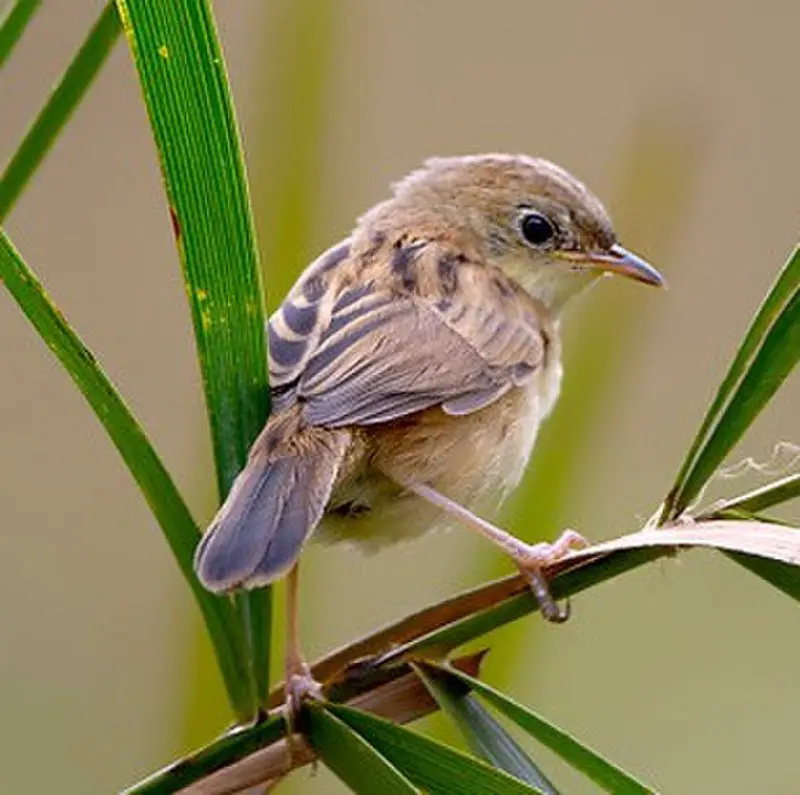
Carruthers’s cisticola is a bird species that belongs to the Cisticolidae family. Its distribution includes Burundi, Kenya, Rwanda, Tanzania, Uganda, and the Democratic Republic of Congo.
The bird’s name honors African Bird Club’s founding member, Mark Carruthers. Its preferred natural habitat is wetlands or swamps for nesting and breeding.
The bird’s appearance and characteristics are unique, but they are not to be copied from the provided information source.
It has distinctive physical features such as small size, rufous streaked feathers, and a pointed bill. The bird’s specific behaviors such as its diet and social behavior may require further investigation.
In conclusion, Carruthers’s cisticola is an interesting bird species that can be found in some African countries.Scientific classification:
| Kingdom | Animalia |
| Phylum | Chordata |
| Class | Aves |
| Order | Passeriformes |
| Family | Cisticolidae |
| Genus | Cisticola |
| Species | C. carruthersi |
14. Brown-Chested Lapwing
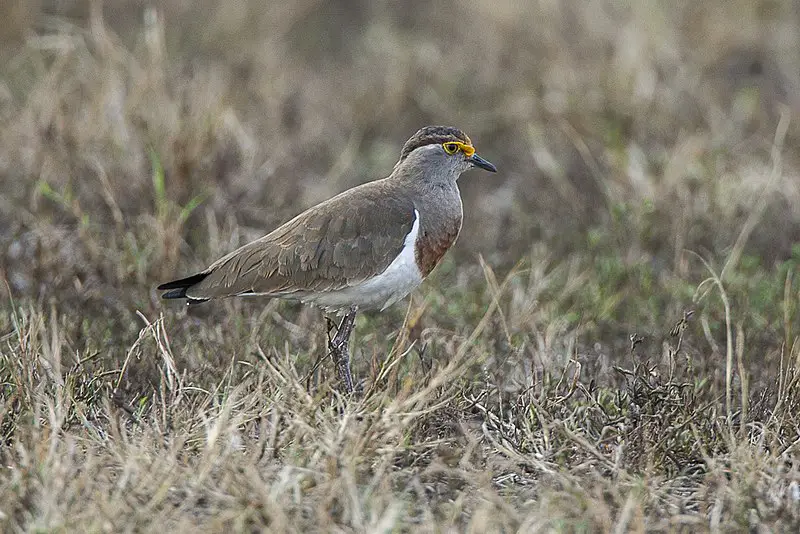
The Brown-chested lapwing is a bird that belongs to the Charadriidae family. It is found in a limited range spanning from southwestern Nigeria to northeastern Democratic Republic of the Congo throughout the year.
In the winters, they move towards Lake Chad, Lake Victoria, and northern Zambia. These carnivorous birds feed on insects like crickets, bugs, and grasshoppers.
They primarily hunt for their prey on the ground. The Brown-chested lapwing is medium-sized and can grow up to 33cm long.
It has a distinct brown chest and a black cap on its head. The bird is also known for its call, which sounds like “Did-he-do-it?” due to the bird’s distinctive and loud call.Scientific classification:
| Kingdom | Animalia |
| Phylum | Chordata |
| Class | Aves |
| Order | Charadriiformes |
| Family | Charadriidae |
| Genus | Vanellus |
| Species | V. superciliosus |